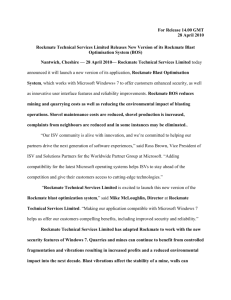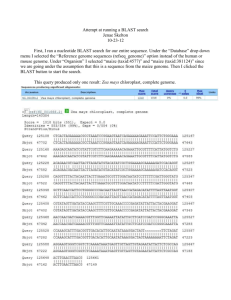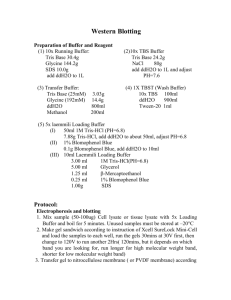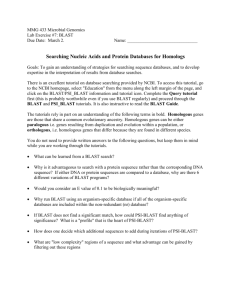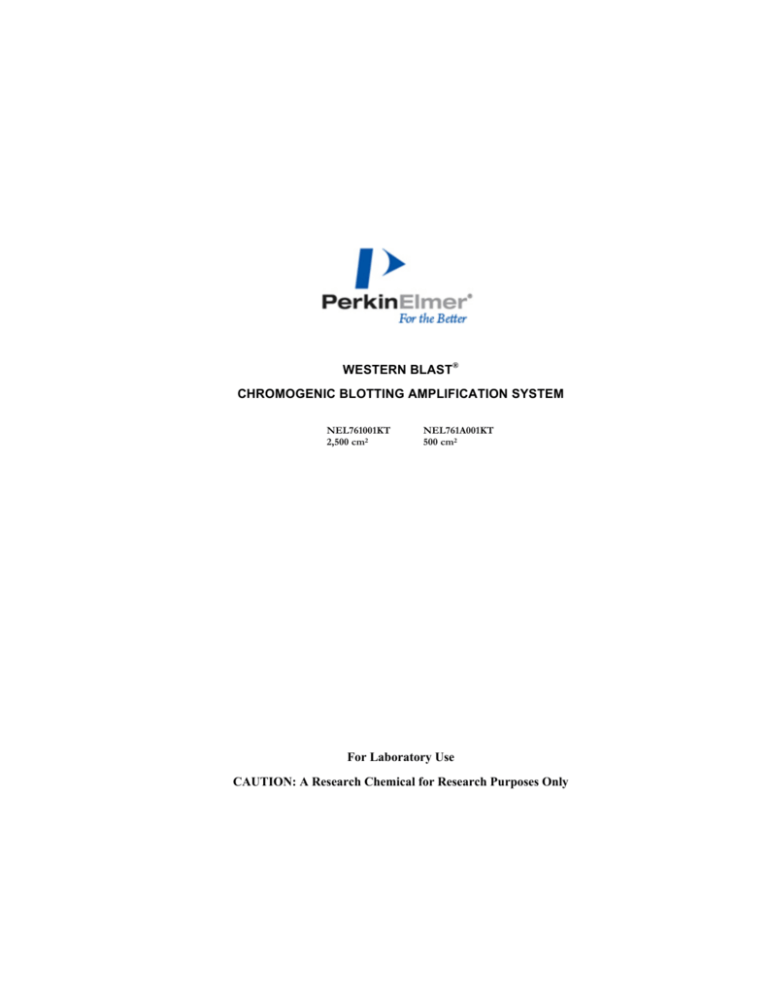
WESTERN BLAST®
CHROMOGENIC BLOTTING AMPLIFICATION SYSTEM
NEL761001KT
2,500 cm2
NEL761A001KT
500 cm2
For Laboratory Use
CAUTION: A Research Chemical for Research Purposes Only
1
2
TABLE OF CONTENTS
I.
II.
III.
Introduction
5
A. Western BLAST
What is Western BLAST?
How does it work?
Chromogenic Detection Options
Membrane Compatibility
5
5
5
6
B. Western BLAST Kits for Western Blotting
Kit Components
Storage and Stability
6
7
Protocol
A. Introduction
Intended Use
Safety Note
Additional Reagents/Equipment Required
8
8
8
8
B. Overview of Protocol
9
C. First Time User
Use of Western BLAST Control Protein
Titration of Antibody Reagents
10
11
D. Standard Protocol
Preparation of Buffers
Step by Step Protocol
11
12
Troubleshooting Guide
14
Problems and Remedies
IV.
Appendices
Appendix 1
Appendix 2
Appendix 3
Appendix 4
V.
PolyScreen® PVDF Membrane
Wetting Protocol
Titration of Antibody Regents
Buffer Formulations
Simplified Western Blotting Protocol
16
16
17
18
20
Complimentary Products
3
4
I.
INTRODUCTION
A.
BLAST and Western Blotting
What is Western BLAST?
In Western blotting, complex mixtures of
proteins are separated by electrophoresis and
transferred to a membrane for subsequent
immunological detection.
Western BLAST is a powerful technology from
PerkinElmer, Inc., that enhances detection
signals for chromogenic western blots at least 810 fold over conventional detection methods. It
is easily integrated into standard protocols,
provided that Horseradish Peroxidase (HRP) is
in the system.
How does Western
BLAST work?
Western BLAST uses proprietary CARD
(catalyzed reporter deposition) technology for
signal amplification in western blots. There is
no change to western blotting protocols through
protein transfer, blocking and incubation with
HRP reagent. HRP catalyzes covalent bonding
of biotin labels to adjacent proteins. The reaction
is quick (less than 15 min) and results in the
deposition of numerous biotin labels close to the
enzyme. These labels can be detected by
standard chromogenic techniques, with
significant enhancement of the signal. Because
the added labels are deposited adjacent to the
enzyme site, there is minimal loss in
resolution.
Chromogenic
Detection Options
Western BLAST kits use an optimized CARD
technology to deposit numerous biotin labels, as
described above. These deposited biotins are
detected with the following chromogenic
detection options:
1. Using Western BLAST Kit Components:
Chromogenic visualization is achieved using
BLAST Streptavidin-Horseradish
Peroxidase (SA-HRP) conjugate followed
by the chromogen 4 CN Plus.
2.
Alternative visualization options (requiring
reagents not supplied):
5
a)
BLAST SA-HRP followed by the
chromogen DAB.
or
b) Streptavidin-Alkaline Phosphatase
followed by BCIP/NBT.
Membrane Compatibility
B.
BLAST has been successfully applied to
nitrocellulose and PolyScreen PVDF, the
preferred membranes for Western Blotting.
(See Appendix 1 for PolyScreen PVDF
membrane wetting protocol).
The Western BLAST kits
Western BLAST is compatible with a wide variety of standard
immunological Western blotting protocols. However, HRP
must be available for amplification to occur. Amplification is
followed by standard chromogenic detection visualization
techniques.
The Western BLAST kits for Western blotting contain the
following components necessary for signal amplification:
Western BLAST Kit Components
NEL761A001KT
500 cm2
NEL761001KT
2,500
cm2
Reagent
Amount
Reagent
Amount
BLAST Streptavidin-HRP
68 µL
BLAST Streptavidin-HRP
320 µL
BLAST Blocking Reagent
1.0 gm
BLAST Blocking Reagent
5.0 gm
BLAST Amplification Diluent
17 mL
BLAST Amplification Diluent
80 mL
BLAST Control Protein
35 µL
BLAST Control Protein
35 µL
BLAST Biotin Reagent
17 mL
BLAST Biotin Reagent
80 mL
BLAST 4CN Plus Chromogenic
Substrate
2.8 mL
BLAST 4CN Plus Chromogenic
Substrate
12.8 mL
BLAST 4CN Plus Substrate
Diluent
14 mL
BLAST 4CN Plus Substrate
Diluent
64 mL
6
Storage and Stability
Upon receipt, the BLAST kit should be stored
at 4°C. The Blocking reagent may be stored at
room temperature if desired. The components in
this kit are stable for a minimum of 6 months
under proper storage conditions.
7
II.
PROTOCOL
A.
Introduction
Intended Use
FOR LABORATORY USE.
The intended use of this kit is to amplify
signals generated by Horseradish Peroxidase. The reagents in this kit have been
modified and optimized for use in membrane based procedures and are not
meant for use with slide immunohistochemistry techniques or microtiter
plates. Reagents for visualization with
chromogens other than 4CN Plus must
be purchased separately.
Safety Note
All reagents are classified as nonhazardous. We strongly recommend
wearing disposable gloves and safety
glasses while working. Thorough washing of hands after handling is also recommended. Do not eat, smoke, or drink
in areas in which reagents are handled.
Additional
Reagents
Phosphate Buffered Saline
Tween® 20
Dimethylsulfoxide (DMSO)
Bovine Serum Albumin (BSA)
PEG-8000
Distilled water
Additional
Equipment
Standard laboratory glassware
Adjustable pipettors
Sterile pipets
Sterile pipet tips
Plastic boxes for incubation of membranes
Polypropylene tubes
Shaker
Plastic forceps
Powder-free gloves
Stirring hot plate
8
B.
Overview of Protocol for Western BLAST
Separate sample proteins by electrophoresis
↓
Standard
Western
Transfer proteins to nitrocellulose or PolyScreen
PVDF membrane.
↓
Blotting
Technique
Block non-specific binding sites with BLAST Blocking
Buffer for 1 hour @ R.T.
↓
Incubate membrane in primary antibody according to
manufacturer’s recommendations.
↓
Wash membrane with wash buffer for 3 x 5 min. @ RT.
↓
Incubate membrane in biotinylated secondary antibody
or HRP-labeled secondary antibody according to
manufacturer’s recommendations.
↓
Wash membranes with wash buffer for 4 x 5 min. @ R.T.
↓
If using biotinylated antibody incubate membrane with
BLAST SA-HRP for 30 min. @ R.T.
↓
Wash membrane with wash buffer for 4 x 5 min. @ R.T.
↓
Signal
Amplification
Incubate membrane in BLAST Biotin Reagent for 10 to
15 min. @ R.T.
↓
Wash membrane 4x for 5 min. in DMSO wash buffer
followed by 1x for 5 min. in wash buffer, all @ R.T.
↓
Incubate membrane in SA-HRP for 30 min. @ RT.
↓
Visualization
Wash membrane 4 x 5 min. in wash buffer.
↓
Add BLAST 4CN Plus.
9
C.
First Time Users
1. Use of Western
BLAST Control
Protein
The biotinylated control protein supplied in
the kit should be used by first time users to
evaluate the amplification technique.
Dilute the BLAST control protein in PBS (for
nitrocellulose) or 40% ethanol/PBS (for PVDF)
according to the following scheme:
Tube
No.
Initial Volume
Add Volume of PBS
or 40% Ethanol/
PBS
1
5 µL of control
protein
20 µL
2
5 µL of tube # 1
20 µL
3
5 µL of tube # 2
20 µL
4
5 µL of tube # 3
20 µL
5
5 µL of tube #4
20 µL
Spot 1 µL of each dilution onto dry nitrocellulose or PolyScreen PVDF. Spot 2 separate
membranes or membrane strips. One will be
used for conventional detection and one used
for amplification with Western BLAST. Both
sets will be detected chromogenically with
4CN Plus.
Proceed to the Western BLAST Standard
Protocol on p. 11. For conventional detection
follow steps (2), (3), (4), (5) and (7) using
SA-HRP at 1:1,000 in step (5). For amplified detection follow steps (2) through (7)
using SA-HRP at 1:1,000 in step (5).
Results should show 1-2 more dots on the
amplified strip.
10
2.
Titration of Antibody Reagents
Technical Support
D.
The high sensitivity achieved with
Western BLAST detection may allow
use of less primary and/or
secondary antibody than that required
for conventional chromogenic
detection. Excess concentrations of
antibodies in Western BLAST
chromogenic detection can lead to high
backgrounds or low signals. See
Appendix 2 for suggested protocols for
reagent titration.
If there are further questions
regarding use of Western BLAST,
please contact PerkinElmer Technical
Support via email at
techsupport@perkinelmer.com before
proceeding.
Standard Protocol
1.
Preparation of Buffers
The following buffers are required for
Western BLAST amplification. (See
Appendix 3 for detailed preparation and
storage instructions and stability
information).
DMSO Wash Buffer
Blocking Buffer
BSA Buffer
Wash Buffer (PBST)
2.
Step by Step Protocol
Western Blotting
(1) Perform electrophoretic separation and
transfer of proteins to appropriate
membrane according to standard
Western blotting protocol.
Blocking Step
(2) Incubate membrane with Western
BLAST Blocking Buffer. Add 0.1 mL/
cm2 and incubate at room temperature
for 1 hour with gentle agitation.
NOTE: The Blocking Reagent
supplied in the kit is optimal for use
with the Western BLAST kit. Other
blocking reagents may lead to
increased background or reduced signal.
11
Suggested
Antibody
Incubation
(3) Drain off the BLAST Blocking Buffer
and add primary antibody diluted in
BLAST Blocking Buffer (or other
buffer as appropriate).
Incubate the primary antibody
preparation using the optimum
concentration determined in
Appendix 2. Follow manufacturer’s
instructions regarding incubation time
and temperature requirements.
(4) Wash the membrane 4 x 5 min. in
BLAST Wash Buffer at room
temperature with gentle agitation.
Suggested
Introduction of HRP
(5) Introduce HRP by one of the
following options (adding volume
of 0.1 mL/cm2):
a.
HRP labeled secondary antibody
diluted in BSA Buffer. Incubate
for 30-60 min. at room
temperature with gentle agitation.
or
b.
12
Biotin labeled secondary antibody
diluted in BSA Buffer. Incubate
for 30-60 min. at room
temperature with gentle agitation.
Wash membrane 4 x 5 min. in
Wash Buffer at room temperature.
Follow with SA-HRP diluted
1:1,000 in BSA Buffer. Incubate
for 30-60 min. at room temperature with gentle agitation.
Amplification
(6) After HRP incubation, proceed with
the following:
a.
Wash the membrane 4 x 5 min. in
Wash Buffer at room temperature
with gentle agitation. Use at least
0.5 mL/cm2 of membrane.
b.
Immediately before use, prepare
working dilution of BLAST
Biotin Reagent by diluting 1:1
with BLAST Amplification
Diluent. Add to membrane in
volume of 0.0625 mL/cm2.
Incubate membranes at room
temperature for 10-15 min. with
gentle agitation. (This incubation
step is facilitated by placing
membrane in hybridization pouch.
It is imperative to keep reagent
evenly distributed over
membrane).
c.
Wash the membrane with DMSO
Wash Buffer 4 x 5 min., followed
by Wash Buffer for 1 x 5 min. at
room temperature. Use at least
0.5 ml/cm2 for each wash.
d.
Dilute Western BLAST SA-HRP
1:1,000 in BSA Buffer. Add to
membrane in a volume of 0.1
mL/cm2. Incubate membranes at
room temperature for 30 min.
with gentle agitation.
e.
Wash the membrane with Wash
Buffer 4 x 5 min. at room temperature.
13
Chromogenic
Visualization with
BLAST 4CN Plus
(7) a.
b.
Alternative
Visualization
(8)
Make 4CN Plus working
dilution fresh before use.
For 10 mL of chromogenic
reagent, add 1 mL 4CN Plus
Substrate Diluent to 9 mL
distilled water. Add 0.2 mL 4CN
Plus Chromogenic Substrate and
mix well. The reagent may appear
turbid.
Place the membrane in the
prepared chromogenic reagent.
Use at least 0.1mL/cm2 and
develop membrane in 4CN Plus
Reagent for up to 30 min. Strong
signals can appear faster, so
development time should be
monitored. Rinse membrane in
water to stop the reaction.
Alternatively chromogenic
visualization can also be carried
out with standard HRP catalyzed
chromogenic substrates such as
DAB (diaminobenzidine) and
AEC (aminoethyl carbazole) or AP
catalyzed substrates such as BCIP/
NBT (5-bromo-4-chloro-indolyl
phosphate/nitro blue tetrazolium).
NOTE: For AP catalyzed substrates,
SA-AP is used in place of
SA- HRP in step 6 (d).
III.
TROUBLESHOOTING GUIDE
Problem
Remedy
Low Signal
· Perform titration of concentration of primary or
secondary antibody and/or increase incubation time.
· Lengthen incubation time of Biotin Reagent.
· Multiple rounds of amplification may increase the
signal.
14
Excess Signal
· Decrease concentration of primary and/or secondary
antibody.
· Decrease BLAST Biotin Reagent incubation time.
· Decrease chromogenic substrate incubation time.
· Decrease concentration of SA-enzyme conjugates.
High Background
· Decrease concentration of primary and/or secondary
antibody or SA-HRP.
· Decrease chromogenic substrate incubation time.
· Increase number and/or length of washes.
· Use only BLAST Blocking Buffer for blocking and antibody diluent.
IV.
APPENDICES
APPENDIX 1: PolyScreen PVDF Membrane Wetting Protocol
Introduction
PolyScreen PVDF Membrane is extremely
hydrophobic and will not wet in an
aqueous solution unless the membrane is
pre-wet with alcohol.
Protocol
Wet the membrane in 95% ethanol for at
least one min. Soak the membrane until it
changes from an opaque white to a uniform
translucent gray.
Rinse the membrane in distilled water to
wash off the alcohol for 2-3 min. If the
membrane floats, gently push it into the
water with plastic forceps until it wets.
Equilibrate the membrane in transfer
buffer. Soak the membrane in the buffer
for 10-15 min. to displace the water and
any bubbles which may form.
NOTE: If the membrane dries (even
partially) at any time during an
experiment, you must wet it with
alcohol and rinse with distilled
water before proceeding.
15
APPENDIX 2: Titration of Antibody Reagants
Introduction
The high sensitivity achieved with Western
BLAST detection sometimes requires the
researcher to use less primary and/or
secondary antibodies than that required for
conventional chromogenic detection.
Excess concentrations of antibodies in
BLAST detection can lead to high
background and/or low signals.
Titration
To achieve the maximum signal to noise
ratio the primary and secondary antibodies
should be optimized in a titration
experiment. The following table gives an
example of a typical titration experiment.
The starting primary antibody dilution is
1:1,000 and the starting secondary antibody
dilution is 1:1,000. The membrane samples
are shown as #1 through #9.
The above titration allows the
determination of the optimum
concentration of the primary and
secondary antibodies for BLAST
chromogenic detection.
Buffer Formulations
PBS
Phosphate Buffered Saline, 10X (10X PBS)
To make 1 liter
2.03 g
NaH2PO4•H2O
Na2HPO4
11.49 g
NaCl
85 g
The pH of the 10X solution is 6.7 to 6.9.
The pH of the 1X solution should be 7.3
to 7.5. If not, adjust the 1X. Storage:
Room temperature.
Alternatively, Dulbecco’s Phosphate
Buffered Saline without calcium chloride
or magnesium chloride (available from
commercial sources) may be used.
Western BLAST Wash
Buffers
BLAST Wash Buffer (PBST)
Phosphate Buffered Saline, pH 7.4 (1X PBS)
0.05% TWEEN 20
16
Primary Antibody Conc.
Secondary Antibody
Conc.
1:1,000
1:2,000
1:4,000
1:1,000
#1
#2
#3
1:2,000
#4
#5
#6
1:4,000
#7
#8
#9
DMSO Wash Buffer
1X PBS
0.05% TWEEN 20
20% DMSO
APPENDIX 3: Buffer Formulations
Western BLAST Blocking Buffer
1X PBS
0.05% TWEEN 20
1.0% BLAST Blocking Reagent
(supplied in kit)
Add Blocking Reagent slowly to buffer with
vigorous stirring. Stir the solution at room
temperature for at least 1 hour. Then, heat the
Blocking Buffer gradually (up to 60°C) with
continuous stirring to dissolve the Blocking
Reagent. The solution should be milky white
with no precipitate evident. Aliquot and store at
-20°C for long term use.
NOTE: The Blocking Reagent supplied in
this kit is optimal for use with the
BLAST kit reagents provided. Other
blocking reagents may lead to
increased background and/or
negligible signal amplification.
Western BLAST BSA Buffer
1X PBST
1.0% BSA
5.0% PEG-8000
Storage: 4°C for 1 month
17
APPENDIX 4: Simplified Western Blotting Protocol
Protocol
1.
It is recommended that the transfer buffer
be made up ahead of time and pre-cooled
to 4°C. In this way, it will have a chance to
degas before use. Bubbles in the transfer
buffer will increase the chance of trapping
air between the membrane and the gel.
Air bubbles create points of high resistance,
resulting in “bald spots” (i.e., areas of lowefficiency transfer and band distortion).
2.
Cut the membrane slightly larger than
the gel. If using a PolyScreen membrane,
pre-wet with ethanol, then rinse with
water. For nitrocellulose, just rinse with
water. Be sure to wear gloves at all times
when handling the membranes. Mark one
side of the membrane for future reference.
3.
Equilibrate both the membrane and the
gel in transfer buffer for 15-20 min.
4.
Wet two Scotch-Brite® pads and two pieces
of filter paper (Whatman® 3MM cut to the
size of the gel) in transfer buffer.
5.
Prepare the “sandwich” as follows:
•
Put one piece of wet filter paper on a
Scotch- Brite pad.
•
Place the equilibrated gel on top of the
filter paper.
•
Place the membrane on top of the gel.
•
Place the second piece of wet filter
paper over the membrane.
•
Be sure to remove any air bubbles
trapped between the gel, membrane,
and filter paper layers. This is easily
done by rolling a clean pipet over the
sandwich.
•
Complete the sandwich with the
second Scotch-Brite pad.
18
6.
Insert the sandwich into the transfer
apparatus with the membrane positioned
between the gel and the appropriate
electrode. Most polypeptides are eluted
from SDS-polyacrylamide gels as anions
and therefore the membrane should usually
be placed between the gel and the anode.
7.
Fill the transfer apparatus with buffer. Pour
the transfer buffer slowly to prevent bubble
formation. Cool to 4°C and transfer at a
constant current or voltage.
8. When the transfer is complete, remove the
membranes and allow them to air dry at
room temperature. Since dehydrated
proteins bind more strongly to the
membrane, this helps to prevent loss of
target during subsequent washes.
V.
COMPLEMENTARY PRODUCTS
HRP Conjugates
Anti-rabbit IgG (goat) HRP
NEF812001EA
Anti-mouse IgG (goat) HRP
NEF822001EA
Anti-human IgG (goat)* HRP
NEF802001EA
Streptavidin HRP
NEL750001EA
Anti-DNP-HRP
FP1128
Antifluorescein-HRP
NEF710001EA
Biotin Conjugates
Anti-rabbit IgG (goat) biotin
NEF813001EA
Anti-mouse IgG (goat) biotin
NEF823001EA
Anti-human IgG (goat) biotin
NEF803001EA
Labeled Streptavidin
Streptavidin Fluorescein
NEL720001EA
Streptavidin Texas Red®
NEL721001EA
Streptavidin Coumarin
NEL722001EA
Streptavidin-HRP
NEL750001EA
Streptavidin-AP
NEL751001EA
19
PolyScreen PVDF Hybridization Transfer Membrane
26.5 cm x 3.75 m roll NEF1002001PK 10 (20 x 20 cm) sheets NEF1000001PK 50 (7 x 8.4 cm) sheets (for mini‐gels) NEF1003001PK Protran® Nitrocellulose (0.2 ìm pore size)
30 cm x 3 m roll NBA083C001EA 5 (15 x 15 cm) sheets NBA083D001EA 5 (33 x 56 cm) sheets NBA083G001EA Protran® Nitrocellulose (0.45 ìm pore size)
15 cm x 3 m roll NBA085A001EA 20 cm x 3 m roll NBA085B001EA 30 cm x 3 m roll NBA085C001EA 5 (15 x 15 cm) sheets NBA085D001EA 5 (33 x 56 cm) sheets NBA085G001EA TSA Kits for Immunohistochemistry and In Situ Hybridization
TSA Fluorescein System
NEL701A001KT
TSA TMR System
NEL702001001KT
TSA Coumarin System
NEL703001KT
TSA Cyanine 3 System
NEL704A001KT
TSA Biotin System
NEL700A001KT
TSA Plus Kits for Immunohistochemistry and In Situ Hybridization
TSA Plus Fluorescein System
NEL741001KT
TSA Plus TMR System
NEL742001KT
TSA Plus Cyanine 3 System
NEL744001KT
TSA Plus Cyanine 5 System*
NEL745001KT
TSA Plus DNP (AP) System
NEL746B001KT
TSA Plus DNP (HRP) System
NEL747B001KT
20
Licensing
This product is covered by US patents 5,196,306, 5,583,001 and 5,731,158 and
foreign equivalents owned by PerkinElmer Inc. It includes a license for
research use only.
21
Notes
22
Notes
Notes
23
PerkinElmer, Inc.
940 Winter Street
Waltham, MA 02451 USA
Phone: (800) 762-4000 or
(+1) 203-925-4602
www.perkinelmer.com
For a complete listing of our global offices, visit www.perkinelmer.com/lasoffices
©2008 PerkinElmer, Inc. All rights reserved. The PerkinElmer logo and design are registered trademarks of PerkinElmer, Inc. All other trademarks not owned by PerkinElmer, Inc. or its subsidiaries that are depicted herein are the property of their respective owners. PerkinElmer reserves the right to change this document at any time without notice and
disclaims liability for editorial, pictorial or typographical errors.
24


